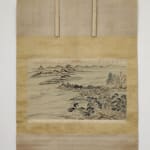Ike no Gyokuran (1727/28−1784)
Boating in Mountain and Water
Color on silk, hanging scroll
Seals: Gyokuran, Shofu
35.3 x 63 cm
123 x 77 cm (overall)
Further images
Literature
Kobijutsu: A Quarterly Review of Fine Arts no. 44. Tokyo: Sansai-sha, 1974.
The brushstrokes employed in the mountains and rocks here are similar to those in Ike no Gyokuran’s Reciting Poems in the Mountains in the Shizuoka Prefectural Museum of Art collection. The Shizuoka scroll was displayed at the Ike Taiga and Tokuyama Gyokuran exhibition in the Philadelphia Museum of Art in 2007. In the exhibition catalog, the brushstrokes of the painting are identified as “ox-tail brushstrokes” according to the Taigado gaho (Taigado’s Painting Manuals). The books, published after Gyokuran’s death, illustrate examples by Taiga for Gyokuran. Gyokuran certainly derived this technique from Taiga, whether or not directly based on the illustrated example. However, Gyokuran developed the technique in her own manner. Both in the Shizuoka painting and the present work, the ox-tail brushstrokes envelop the surface of the rocks. The same signature style and “Gyokuran” and “Shofu” seals of the Shizuoka painting and the present work indicate that they might be painted in the same period. Gyokuran’s works are hardly dated. Judging from the matured style, these two works might belong to her late works.
The scroll box contains a letter, in which “Kaga-ya,” apparently an art dealer, asked “Higashiyama,” probably Taigado Giryo, about the authenticity of the scroll. The painting is titled Ferry in Matsushima in the letter, but here we adopt the title Boating in Mountain and Water from Kobijutsu No. 44, in which this painting is published.
Ike no Gyokuran (painter, poet; 1727/28–1784)
Also known as Shofu, Kattankyo.
Kyoto-born mid to late-Edo period painter and poet. Wife of Ike no Taiga. Her mother is Yurijo of Gion. Her real name is Machiko. Studied under Yanagizawa Kien, and her style resembles to that of Taiga. Particularly excelled at painting orchard, bamboo, plum blossom, and chrysanthemum. Also known for her waka writing. Led a life of freedom as Taiga, and left many anecdotes behind.
The scroll box contains a letter, in which “Kaga-ya,” apparently an art dealer, asked “Higashiyama,” probably Taigado Giryo, about the authenticity of the scroll. The painting is titled Ferry in Matsushima in the letter, but here we adopt the title Boating in Mountain and Water from Kobijutsu No. 44, in which this painting is published.
Ike no Gyokuran (painter, poet; 1727/28–1784)
Also known as Shofu, Kattankyo.
Kyoto-born mid to late-Edo period painter and poet. Wife of Ike no Taiga. Her mother is Yurijo of Gion. Her real name is Machiko. Studied under Yanagizawa Kien, and her style resembles to that of Taiga. Particularly excelled at painting orchard, bamboo, plum blossom, and chrysanthemum. Also known for her waka writing. Led a life of freedom as Taiga, and left many anecdotes behind.









